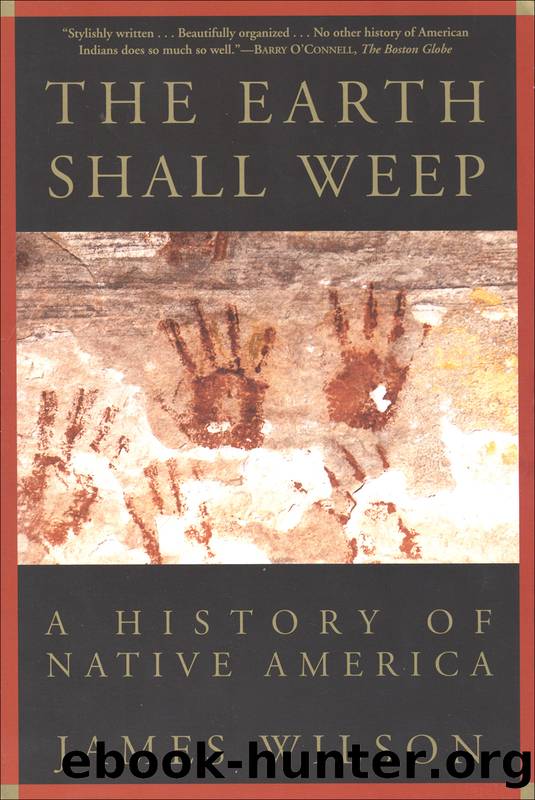The Earth Shall Weep by James Wilson

Author:James Wilson
Language: eng
Format: epub
Publisher: Grove Atlantic
Published: 2010-07-14T16:00:00+00:00
9. The Great Plains
The heart of everything that is
A long time ago my father told me what his father told him, that there was once a Lakota holy man, called Drinks Water, who dreamed what was to be; and this was long before the coming of the Wasichus. He dreamed that the four-leggeds were going back into the earth and that a strange race had woven a spiders web around the Lakotas. And he said: When this happens, you shall live in square grey houses, in a barren land, and beside those square grey houses you shall starve.’ They say he went back to Mother Earth soon after he saw this vision, and it was sorrow that killed him. You can look about you now and see that he meant these dirt-roofed houses we are living in, and that all the rest was true. Sometimes dreams are wiser than waking.
Black Elk, Lakota
The Plains - a huge wedge of grassland, roughly divided into ‘prairie’ in the east and the drier ‘high plains’ of the west, driven through the heart of North America from Canada to Texas - was the last major area in the continental United States to be settled by Euro-Americans. It is easy to see why. Apart from a few isolated pockets of higher ground -the Ozarks in Missouri, the Black Hills and Badlands in South Dakota - and clusters of cottonwood, willow and chokecherry trees along sheltered creeks and rivers, the same flat, open landscape stretches nearly unbroken from the Mississippi Valley to the Rockies. Exposed to almost Saharan heat in summer and subarctic cold in winter, swept by high winds and sudden violent storms, it seemed so repellent and worthless that some early nineteenth-century maps refer to it as the ‘Great American Desert’. For emigrants used to the domestic agricultural landscape of Europe or East coast America and yearning for a farm of their own, it must have appeared no more than a desolate wilderness, a final test of their faith and endurance before they reached the lush, temperate promised land of Oregon or California.
Because it was the final military conflict in the long struggle for possession of North America, the war for the Plains, when it did come, has attained a unique place in the national mythology of the United States - and, since America so powerfully dominates the global imagination, in the mythology of the world. It was recorded by photographers, dramatized by popular novelists and - first through spectacles such as Buffalo Bill’s Wild West Show and then through the new medium of film - transformed into the most potent symbol of the triumph of Manifest Destiny. In popular culture and the popular imagination, it came to represent the ultimate, archetypal encounter between the timeless, unchanging, elemental Savage and the dynamic, thrusting European. It was the defeat of the Plains tribes that seemed to consign the Indian irreversibly to history and finally put the stamp of ‘civilization’ on the entire continent.
There is something deeply ironic - though somehow strangely fitting - about this.
Download
This site does not store any files on its server. We only index and link to content provided by other sites. Please contact the content providers to delete copyright contents if any and email us, we'll remove relevant links or contents immediately.
| African-American Studies | Asian American Studies |
| Disabled | Ethnic Studies |
| Hispanic American Studies | LGBT |
| Minority Studies | Native American Studies |
Cecilia; Or, Memoirs of an Heiress — Volume 1 by Fanny Burney(31332)
Cecilia; Or, Memoirs of an Heiress — Volume 3 by Fanny Burney(30934)
Cecilia; Or, Memoirs of an Heiress — Volume 2 by Fanny Burney(30889)
The Great Music City by Andrea Baker(21283)
We're Going to Need More Wine by Gabrielle Union(18072)
Bombshells: Glamour Girls of a Lifetime by Sullivan Steve(13108)
Pimp by Iceberg Slim(12931)
All the Missing Girls by Megan Miranda(12747)
Fifty Shades Freed by E L James(12451)
Norse Mythology by Gaiman Neil(11883)
Talking to Strangers by Malcolm Gladwell(11876)
Crazy Rich Asians by Kevin Kwan(8349)
Mindhunter: Inside the FBI's Elite Serial Crime Unit by John E. Douglas & Mark Olshaker(7834)
The Lost Art of Listening by Michael P. Nichols(6472)
Enlightenment Now: The Case for Reason, Science, Humanism, and Progress by Steven Pinker(6405)
Bad Blood by John Carreyrou(5768)
The Four Agreements by Don Miguel Ruiz(5510)
Weapons of Math Destruction by Cathy O'Neil(5036)
We Need to Talk by Celeste Headlee(4868)
